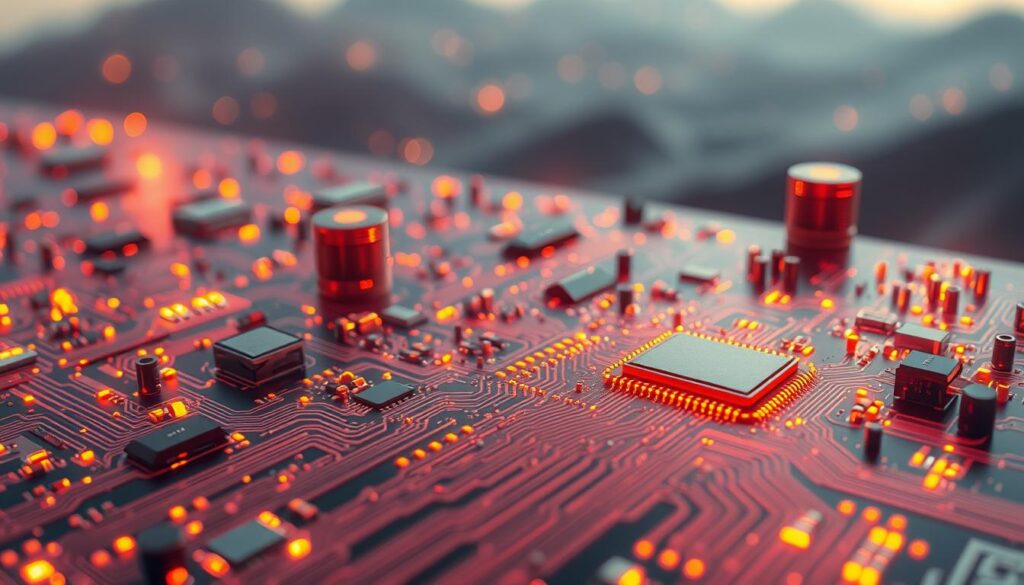The field of electrical and electronics engineering is revolutionizing the way we live and work. By harnessing the power of engineering technology, professionals in this field are creating innovative solutions to real-world problems.
Electrical systems and electronics systems are at the heart of modern infrastructure, from power grids to consumer electronics. As technology advances, the demand for skilled engineers who can design, develop, and maintain these systems continues to grow.
Key Takeaways
- The importance of electrical and electronics engineering in modern society.
- The role of engineering technology in driving innovation.
- The impact of electrical and electronics systems on daily life.
- The growing demand for skilled engineers in this field.
- The potential for future advancements in electrical and electronics engineering.
The Foundation of Modern Technology
At the heart of modern technological advancements lies the discipline of electrical and electronics engineering, driving progress and innovation. This field has not only transformed the way we live and work but has also paved the way for future breakthroughs.
Defining the Scope and Impact
Electrical and electronics engineering encompasses a broad range of subfields, including circuit theory, electronics, electromagnetism, and signal processing. The impact of this discipline is vast, influencing areas such as telecommunications, power generation, and electronic device manufacturing. Electrical components and electronic devices are integral to modern life, found in everything from smartphones to medical equipment.
Historical Evolution and Milestones
The history of electrical and electronics engineering is marked by significant milestones, from the discovery of electricity to the development of the first electronic computers. The field has evolved rapidly, with advancements in engineering principles leading to the creation of smaller, faster, and more efficient electronic devices. Key figures such as Nikola Tesla and Thomas Edison have played crucial roles in shaping the discipline.
The evolution continues, with ongoing research and innovation pushing the boundaries of what is possible in electrical and electronics engineering.
Understanding Electrical and Electronics Engineering
Understanding the intricacies of electrical and electronics engineering requires a solid grasp of circuit theory, electromagnetism, and signal processing fundamentals. These foundational concepts are crucial for designing, developing, and maintaining modern electrical systems.
Circuit Theory and Analysis
Circuit theory is a fundamental aspect of electrical engineering, dealing with the analysis and design of electrical circuits. It involves understanding the behavior of circuits under various conditions, including the flow of current, voltage drops, and power dissipation. Circuit analysis techniques, such as Kirchhoff’s laws and Thevenin’s theorem, are essential tools for engineers to simplify complex circuits and predict their behavior.
As stated by Charles Alexander and Matthew Sadiku, “Circuit analysis is the process of determining the voltage across and the current through each component in a circuit.” This quote highlights the importance of circuit analysis in understanding how electrical circuits function.
Electromagnetic Principles
Electromagnetic principles form another cornerstone of electrical and electronics engineering. Electromagnetics involves the study of the interactions between electric charges and the electromagnetic force, one of the four fundamental forces of nature. Understanding electromagnetic theory is vital for designing and analyzing systems that involve electromagnetic waves, such as antennas, transmission lines, and electromagnetic compatibility (EMC).

Signal Processing Fundamentals
Signal processing is a critical area of study in electrical and electronics engineering, focusing on the analysis, modification, and synthesis of signals. Signals can be in the form of sound, images, or other forms of data. Signal processing techniques are used in a wide range of applications, from audio processing in music systems to image processing in medical imaging devices.
As technology advances, the importance of signal processing continues to grow, with applications in telecommunications, control systems, and more. Understanding signal processing fundamentals is essential for engineers working in these fields.
Core Disciplines Within the Field
At the heart of Electrical and Electronics Engineering lie several fundamental disciplines that shape the modern technological landscape.
Power Systems Engineering
Power Systems Engineering is a critical discipline that deals with the generation, transmission, and distribution of electrical power. It involves the design and operation of electrical grids, ensuring reliable and efficient supply of electricity. Key aspects include power system analysis, stability, and control.
Electronics and Microelectronics
Electronics and Microelectronics involve the study and application of electronic devices and circuits. This discipline has led to the development of miniature electronic devices, enhancing performance and reducing power consumption. Microelectronics has revolutionized the field, enabling the production of complex integrated circuits.
Control Systems Engineering
Control Systems Engineering focuses on the design and implementation of control systems that govern the behavior of other systems. It is crucial in applications ranging from robotics to aerospace. Control systems ensure stability and precision in various engineering applications.
| Discipline | Key Focus | Applications |
|---|---|---|
| Power Systems Engineering | Generation, transmission, distribution | Electrical grids, power supply |
| Electronics and Microelectronics | Electronic devices, circuits | Consumer electronics, integrated circuits |
| Control Systems Engineering | System control, stability | Robotics, aerospace, industrial automation |
Digital Revolution in Electrical Engineering
The advent of digital technologies has revolutionized the field of electrical engineering, transforming the way systems are designed, implemented, and operated. This revolution is largely attributed to advancements in digital electronics and digital circuits, which have enabled the development of more efficient, compact, and powerful electrical systems.
Digital Circuits and Systems
Digital circuits form the backbone of modern electrical engineering, facilitating the creation of complex systems that are both versatile and reliable. These circuits are used in a myriad of applications, from simple electronic devices to sophisticated computing systems. The design and analysis of digital circuits involve understanding Boolean logic and the implementation of logic gates.
Digital Signal Processing
Digital Signal Processing (DSP) is a critical aspect of modern electrical engineering, enabling the manipulation and analysis of signals in various domains. DSP has numerous applications, including audio processing, image processing, and telecommunications.
Real-time Applications
Real-time applications of DSP are crucial in systems that require immediate processing and response, such as in control systems and audio processing. These applications demand high-speed processing and low latency.
Advanced Algorithms
The development of advanced algorithms is vital for enhancing the capabilities of DSP systems. These algorithms enable more efficient signal processing, improved accuracy, and the ability to handle complex data sets.
Computer Engineering Integration
The integration of computer engineering with electrical engineering has led to the development of sophisticated systems that combine hardware and software components. This integration is evident in the design of embedded systems, where computer engineering principles are used to create efficient and reliable systems.
The synergy between digital electronics and computer engineering is driving innovation in electrical engineering, leading to more powerful and efficient systems. As technology continues to evolve, the importance of digital circuits and digital signal processing will only continue to grow.

Telecommunications and Communication Systems
In the realm of electrical and electronics engineering, telecommunications and communication systems stand out as pivotal elements shaping our connected world. These systems have revolutionized the way we communicate, enabling rapid data exchange across vast distances.
Wireless Communication Technologies
Wireless communication technologies have seen tremendous growth, with advancements in cellular networks, Wi-Fi, and satellite communications. These technologies have enabled ubiquitous connectivity, allowing people to stay connected from anywhere.
- Cellular networks have evolved from 1G to 5G, offering faster data rates and lower latency.
- Wi-Fi has become a staple for local area networking, providing high-speed internet access.
- Satellite communications continue to play a crucial role in global connectivity, especially in remote areas.
Network Infrastructure in the US
The United States boasts a robust network infrastructure, comprising a mix of fiber-optic cables, cell towers, and data centers. This infrastructure supports the vast demands of modern telecommunications, facilitating seamless communication across the country.
Key aspects of the US network infrastructure include:
- Extensive fiber-optic networks that provide high-speed data transmission.
- A dense array of cell towers that support mobile connectivity.
- Strategically located data centers that store and process vast amounts of data.
5G and Beyond: Future Communication
The advent of 5G technology marks a significant milestone in telecommunications, offering enhanced data rates and ultra-low latency. As we look beyond 5G, researchers are exploring new technologies that will further transform the landscape of telecommunications.
Some of the anticipated advancements include:
- Improved spectral efficiency.
- Integration of artificial intelligence in network management.
- Enhanced security measures to protect user data.
Power Generation and Distribution Systems
The backbone of modern civilization, power generation and distribution systems are crucial for delivering electricity from producers to consumers. These systems are complex networks that involve the generation, transmission, and distribution of electrical power.

Traditional Power Generation Methods
Traditional power generation methods primarily involve the use of fossil fuels such as coal, natural gas, and oil to produce electricity. Coal-fired power plants have been a dominant source of electricity generation in the United States for decades. However, the landscape is changing with the increasing adoption of cleaner energy sources.
Natural gas-fired power plants are becoming more prevalent due to their lower emissions and flexibility in operation. Nuclear power plants also contribute significantly to the electricity mix, providing a substantial portion of the country’s power without emitting greenhouse gases during operation.
American Electrical Grid Infrastructure
The American electrical grid is a vast network that includes power generation plants, transmission lines, substations, and distribution lines. It is one of the most complex machines ever built, with the capability to deliver power to millions of consumers. The grid is divided into three main interconnections: the Eastern, Western, and ERCOT (Electric Reliability Council of Texas) interconnections.
Reliability and resilience are critical aspects of the grid infrastructure, with ongoing efforts to upgrade and modernize the system to meet current and future energy demands. The grid faces challenges such as aging infrastructure, increasing demand, and the integration of renewable energy sources.
Smart Grid Technologies and Implementation
Smart grid technologies represent a significant advancement in the modernization of the electrical grid. These technologies include advanced metering infrastructure, grid management systems, and energy storage solutions. Smart grids enable real-time monitoring and management of electricity distribution, improving efficiency and reducing the likelihood of power outages.
The implementation of smart grid technologies is crucial for accommodating the increasing penetration of renewable energy sources and enhancing the overall resilience of the grid. Initiatives across the United States are underway to deploy these technologies, with a focus on creating a more flexible, responsive, and consumer-friendly grid.
Renewable Energy and Sustainable Solutions
The importance of renewable energy and sustainable solutions in today’s world cannot be overstated. As we continue to grapple with the challenges of climate change and environmental degradation, the need for clean and sustainable energy sources has become more pressing than ever.
Solar and Wind Power Systems
Solar and wind power are two of the most promising renewable energy sources. They offer a cleaner alternative to traditional fossil fuels, reducing greenhouse gas emissions and helping to mitigate climate change.
Photovoltaic Technology Advances
Advances in photovoltaic technology have significantly improved the efficiency and affordability of solar power. Modern solar panels are more efficient and cost-effective, making solar energy a viable option for both residential and commercial use.
Wind Turbine Design Innovations
Innovations in wind turbine design have also contributed to the growth of wind power. Larger, more efficient turbines can now generate more electricity than ever before, making wind energy a significant player in the renewable energy landscape.
Energy Storage Technologies
Energy storage technologies are crucial for the widespread adoption of renewable energy sources. They enable the storage of excess energy generated by solar and wind power, ensuring a stable and reliable energy supply.
- Battery storage systems are becoming increasingly popular.
- Advanced technologies like pumped hydro storage and compressed air energy storage are also being developed.
US Renewable Energy Initiatives
The United States has been actively promoting renewable energy initiatives. Various policies and programs have been implemented to encourage the development and use of renewable energy sources.
Key initiatives include:
- Tax credits for renewable energy projects.
- State-level renewable portfolio standards.
- Investment in renewable energy research and development.
These efforts are expected to drive the growth of the renewable energy sector in the US, contributing to a more sustainable energy future.
Semiconductor Technology and Devices
At the heart of modern electronics lies semiconductor technology, enabling faster, smaller, and more efficient devices. Semiconductor devices, including transistors and integrated circuits, are the backbone of contemporary electronics, powering everything from smartphones to sophisticated computing systems.
Transistors and Integrated Circuits
Transistors are fundamental components in electronic circuits, acting as switches or amplifiers. The invention of the transistor revolutionized electronics, leading to the development of integrated circuits that combine multiple transistors on a single chip of semiconductor material. This integration has significantly enhanced performance and reduced the size and cost of electronic devices.
![]()
American Semiconductor Industry
The American semiconductor industry has been a global leader, driven by innovation and significant investments in research and development. Companies like Intel and Texas Instruments have pioneered advancements in semiconductor technology, contributing to the country’s strong presence in the global market.
| Company | Specialization | Notable Achievements |
|---|---|---|
| Intel | Microprocessors | Pioneered the development of the first microprocessor |
| Texas Instruments | Analog and Embedded Processing | Developed the first commercial transistor radio |
Future of Semiconductor Technology
The future of semiconductor technology is promising, with ongoing advancements aimed at further miniaturization and increased efficiency. Emerging technologies, such as quantum computing and 3D stacked integration, are expected to drive the next wave of innovation in the semiconductor industry.
As the demand for more powerful and energy-efficient devices continues to grow, the semiconductor industry is poised to play a crucial role in shaping the future of technology.
Embedded Systems and IoT Applications
Embedded systems and IoT applications are at the forefront of technological innovation, transforming industries worldwide. The synergy between these technologies is creating more sophisticated and interconnected devices, revolutionizing the way we live and work.
Embedded System Design Principles
Embedded system design involves creating systems that are tailored to perform specific tasks efficiently. These systems are integral to a wide range of devices, from consumer electronics to industrial machinery. Key principles include optimizing for performance, power consumption, and cost, while ensuring reliability and security.
Reliability is crucial in embedded systems, as they often operate in critical applications where failure is not an option. Designers must consider factors such as hardware reliability, software robustness, and the ability to withstand various environmental conditions.
Internet of Things Architecture
IoT architecture refers to the framework that enables the integration and interaction of IoT devices. It encompasses the hardware, software, and communication protocols necessary for IoT systems to function effectively. A well-designed IoT architecture is scalable, secure, and capable of handling the vast amounts of data generated by IoT devices.
The IoT architecture typically includes several layers, such as the device layer, network layer, and application layer, each playing a vital role in the overall functionality of the IoT system.
Smart Home and Industrial Applications
IoT and embedded systems are transforming both smart homes and industrial settings. In smart homes, these technologies enable automation, energy efficiency, and enhanced security. In industrial environments, they improve productivity, safety, and equipment maintenance through predictive analytics and real-time monitoring.
For instance, smart home systems can integrate lighting, heating, and security systems into a single, user-friendly interface, enhancing convenience and comfort. In industrial settings, IoT-enabled sensors can monitor equipment health, predicting failures before they occur, thus reducing downtime and maintenance costs.
Robotics and Automation in Engineering
The field of engineering is experiencing a paradigm shift with the incorporation of robotics and automation technologies. This transformation is evident across various industries, where robotics and automation are enhancing efficiency, productivity, and precision.

Industrial Automation Systems
Industrial automation systems are revolutionizing manufacturing processes by integrating advanced robotics and control systems. These systems enable companies to streamline production, reduce costs, and improve product quality. Key benefits include increased efficiency and reduced labor costs.
Robotics Control and Programming
Robotics control and programming are critical components of modern automation. Advanced programming techniques and control systems allow for more sophisticated robot behaviors and interactions with their environment.
PLC Programming Essentials
PLC (Programmable Logic Controller) programming is a fundamental skill in industrial automation. PLCs are used to control machinery and manufacturing processes, requiring precise and efficient programming to ensure optimal performance.
Machine Vision Systems
Machine vision systems are increasingly being used in robotics and automation to enhance inspection, identification, and navigation tasks. These systems enable robots to interpret and respond to visual data from their environment.
Human-Machine Interfaces
Human-machine interfaces (HMIs) are crucial for effective interaction between humans and automated systems. Modern HMIs are designed to be intuitive and user-friendly, allowing operators to monitor and control complex processes easily. Effective HMIs improve operational efficiency and reduce the risk of errors.
Education and Career Pathways in the US
Electrical and electronics engineering education in the US is designed to equip students with the knowledge and skills needed for a successful career. With a strong foundation in both theoretical and practical aspects, graduates are well-prepared to tackle the challenges of the ever-evolving engineering landscape.
Top Engineering Programs and Specializations
The US hosts some of the world’s most prestigious electrical and electronics engineering programs. Institutions like MIT, Stanford, and UC Berkeley offer a wide range of specializations, from power systems and electronics to telecommunications and signal processing. Students can choose from various undergraduate and graduate programs tailored to their interests and career aspirations.
Some of the top specializations include:
- Power Systems Engineering
- Electronics and Microelectronics
- Control Systems Engineering
- Digital Signal Processing
Professional Certifications and Licensing
Obtaining professional certifications and licenses is a crucial step in the career development of electrical and electronics engineers. Certifications like the PE (Professional Engineer) license demonstrate a level of competence and commitment to the profession. Organizations such as the National Council of Examiners for Engineering and Surveying (NCEES) provide resources and guidelines for licensure.
“Certification is a mark of excellence, showing that an engineer has met rigorous standards and is capable of delivering high-quality work.” – NCEES
Career Opportunities and Salary Outlook
Electrical and electronics engineers in the US have a wide range of career opportunities across various industries, including energy, telecommunications, manufacturing, and technology. According to the Bureau of Labor Statistics, the median annual salary for electrical engineers is around $100,000, with experienced professionals earning significantly more.
| Industry | Median Salary |
|---|---|
| Energy | $105,000 |
| Telecommunications | $110,000 |
| Manufacturing | $95,000 |
Industry Standards and Safety Practices
In the rapidly advancing field of electrical and electronics engineering, industry standards and safety practices are fundamental to fostering a culture of safety and excellence. These standards not only ensure the reliability and performance of electrical systems but also safeguard against potential hazards.

US Electrical Safety Regulations
The United States has a comprehensive framework for electrical safety regulations, primarily governed by the National Electrical Code (NEC). The NEC provides guidelines for the safe installation, operation, and maintenance of electrical systems. Compliance with these regulations is crucial for preventing electrical accidents and ensuring public safety.
Key aspects of US Electrical Safety Regulations include:
- Proper grounding and bonding of electrical systems
- Adequate insulation and protection of electrical conductors
- Safe installation of electrical equipment and devices
Testing and Certification Processes
Testing and certification are critical components of ensuring compliance with industry standards and safety practices. Organizations such as Underwriters Laboratories (UL) and the International Electrotechnical Commission (IEC) provide testing and certification services for electrical products. These processes verify that products meet specific safety and performance standards.
The testing and certification process typically involves:
- Product testing to ensure compliance with relevant standards
- Certification marking to indicate compliance
- Ongoing monitoring to ensure continued compliance
Ethical Considerations in Engineering Practice
Ethical considerations play a vital role in the practice of electrical and electronics engineering. Engineers must adhere to a code of ethics that prioritizes public safety, integrity, and environmental responsibility. This includes being aware of the potential impacts of their designs and decisions on society and the environment.
Key ethical considerations include:
- Ensuring the safety and well-being of the public
- Avoiding conflicts of interest and maintaining professional integrity
- Considering the environmental impact of engineering decisions
The Future of Electrical and Electronics Engineering
As we look to the future, electrical and electronics engineering are poised to undergo significant transformations driven by emerging technologies. The integration of new technologies and methodologies is expected to revolutionize the field, enabling more efficient, sustainable, and innovative solutions.
Artificial Intelligence Integration
Artificial intelligence (AI) is set to play a crucial role in the future of electrical and electronics engineering. AI can enhance system design, optimize performance, and predict potential failures. For instance, AI algorithms can be used to analyze complex data sets, identify patterns, and make informed decisions.
The application of AI in engineering is vast, ranging from intelligent control systems to advanced data analytics. As AI technology continues to evolve, we can expect to see more sophisticated applications in the field.
Quantum Computing Applications
Quantum computing represents another significant area of development in electrical and electronics engineering. Quantum computers have the potential to solve complex problems that are currently unsolvable with traditional computing technology.
The impact of quantum computing on fields such as cryptography, optimization problems, and complex system simulations is expected to be profound. As research in quantum computing advances, we can anticipate new applications and innovations in electrical and electronics engineering.
| Technology | Application | Potential Impact |
|---|---|---|
| Artificial Intelligence | System Design and Optimization | Enhanced Efficiency and Performance |
| Quantum Computing | Cryptography and Complex Simulations | Revolutionary Problem-Solving Capabilities |
| Sustainable Engineering | Renewable Energy Systems | Reduced Environmental Impact |
Sustainable Engineering Innovations
Sustainable engineering is becoming increasingly important as the world shifts towards more environmentally friendly practices. Innovations in sustainable engineering are crucial for reducing the environmental impact of electrical and electronics systems.
Advances in renewable energy technologies, energy storage, and efficient system design are key areas of focus. By developing more sustainable solutions, engineers can help mitigate environmental challenges and create a more sustainable future.
Conclusion: Engineering a Brighter Tomorrow
Electrical and electronics engineering is the backbone of modern technology, driving innovations that transform our daily lives. From power generation and distribution to telecommunications and digital systems, this field has revolutionized the way we live, work, and communicate.
As we look to the future, the importance of electrical and electronics engineering will only continue to grow. Advances in artificial intelligence, quantum computing, and sustainable energy solutions are poised to shape the next generation of technological breakthroughs. The future of engineering is bright, with innovations in electrical and electronics engineering leading the way.
With the integration of emerging technologies, the potential for electrical and electronics engineering to create a brighter tomorrow is vast. By continuing to push the boundaries of what is possible, engineers in this field will remain at the forefront of innovation, driving progress and improving lives.
